- About Ramapo
- Academics
- Admissions & Aid
- Student Life
- Athletics
- Alumni
- Arts & Community
- Quick Links
- Apply
- Visit
- Give
GUMPERT TEACHERS’ WORKSHOP HIGHLIGHTS NEW RESEARCH AND TEACHING STRATEGIES ON KRISTALLNACHT
(PDF) (DOC) (JPG)January 24, 2014
(MAHWAH, NJ) – On November 14, 2014, the Gross Center for Holocaust and Genocide Studies sponsored a Gumpert Teachers’ Workshop, “75 Years After Kristallnacht: New Perspectives and Teaching Strategies.” Supported by the New Jersey State Commission on Holocaust Education, the workshop was held at Ramapo College and was attended by fifty-six educators from throughout New Jersey.
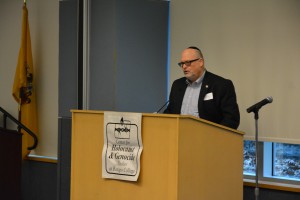 Welcoming participants on behalf of the New Jersey Commission on Holocaust Education was one of its members, Yitz Stern. He stood in for Executive Director Dr. Paul Winkler, who was recuperating from surgery at the time. A resident of Teaneck, Stern has been a member of its township council since 1998. In his work life, he is Fiscal Analyst at Bergen County’s Law & Public Safety Institute and is also an Adjunct Professor of Administration and Business at Farleigh Dickenson University. The child of Holocaust survivors, he emphasized the crucial role that teaching about the genesis of Hitler’s war against the Jews plays in producing an informed, engaged and tolerant citizenry that represent our best hope of preventing a regime like that established by the Nazis coming to power.
Welcoming participants on behalf of the New Jersey Commission on Holocaust Education was one of its members, Yitz Stern. He stood in for Executive Director Dr. Paul Winkler, who was recuperating from surgery at the time. A resident of Teaneck, Stern has been a member of its township council since 1998. In his work life, he is Fiscal Analyst at Bergen County’s Law & Public Safety Institute and is also an Adjunct Professor of Administration and Business at Farleigh Dickenson University. The child of Holocaust survivors, he emphasized the crucial role that teaching about the genesis of Hitler’s war against the Jews plays in producing an informed, engaged and tolerant citizenry that represent our best hope of preventing a regime like that established by the Nazis coming to power.
Acclaimed scholar and author Dr. Marion A. Kaplan, Skirball Professor of Modern Jewish History and Director of Graduate Studies in History at New York University, spoke in her keynote lecture about the transformative role that the November 10, 1938 pogrom of Kristallnacht and the events preceding it had on the lives of Jewish women and families in Germany.
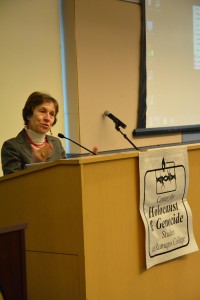
As persecution mounted and Jewish men lost their livelihoods and were mostly held inconcentration camps, the women effectively became the heads of the households involved, increasingly assuming roles and responsibilities that would have been unthinkable prior to the advent of Hitler. Mothers, daughters and sisters who previously had led their lives primarily within their families became responsible for their families’ well being that increasingly revolved around making the complex, difficult and uncertain preparations to emigrate. Always far from easy, their task became ever more problematic in the wake of Kristallnacht, not least because assurances of emigration became a condition for the release of the vast majority of Jewish men taken into custody and sent to concentration camp during the pogrom.
Professor Kaplan concluded her presentation with a review of new research and writing on the November Pogrom indicating that the Nazi hierarchy, under pressure from more “radical” elements in the provinces, was looking for the excuse for something new and more violent to happen. That opportunity came, of course, with the shooting and subsequent death of Ernst vom Rath, a low level diplomat in the Third Reich’s Paris embassy, by a young Polish émigré, Herschel Grynszpan.
As Kaplan pointed out, a new book by Jonathan Kirsch, The Short, Strange Life of Herschel Grynszpan: A Boy Avenger, a Nazi Diplomat, and a Murder in Paris, while not refuting the accepted narrative of a teenager seeking revenge for the expulsion from Germany of his Polish-Jewish family, places developments in the context of increasingly exclusionist policies being adopted in Berlin and Warsaw as well as some circumstantial evidence that vom Rath and Grynszpan may have previously been involved in some sort of sexual relationship.
Professor Kaplan’s own scholarship and books include Dominican Haven: The Jewish Refugee Settlement in Sosúa, 1940-1945 (New York, 2008), Jewish Daily Life in Germany, 1618-1945 (Oxfor University Press, 2005), Between Dignity and Despair: Jewish Life in Nazi Germany (Oxford University Press, 1998), The Making of the Jewish Middle Class: Women, Family, and Identity in Imperial Germany (New York, Oxford University Press, 1991) and The Jewish Feminist Movement in Germany: The Campaigns of the Juedischer Frauenbund, 1904-1938 (Connecticut: Greenwood Press, 1979. A hallmark of her scholarly output has been its reliance not only on archival sources, but also on ego-documents, such as diaries, letters, and memoirs that express feelings and personal perspectives along with the crucial details of daily life.
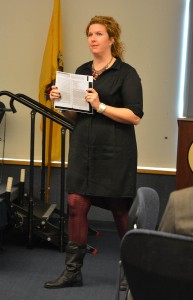 The next presentation, by Barnegat High School teacher Lindsey-Ann Thomson, was on “Kristallnacht: Bringing The Night of Broken Glass to 21st Century Learners.” Using current technology and social media, Thomson demonstrated several exciting and innovative ways to connect her students with the subject matter. For instance, she involved workshop participants in modeling how the analysis of images using interactive technology could enhance learning opportunities for today’s tech-savvy students. Similarly, the availability of primary sources on the Internet opens the possibility for students to engage in textual analysis and piece together an historical narrative on their own. In this process, students become empowered and teachers function as facilitators in learning. An analogous process is at work when Thomson and her students analyze the diary entries of young people caught up in the Holocaust contained in Alexandra Zapruder’s collection, Salvaged Pages (Yale University Press, 2004). Thomson has also fostered student engagement by constructing dynamic timelines that expand as the class delves deeper into the history of the Holocaust.
The next presentation, by Barnegat High School teacher Lindsey-Ann Thomson, was on “Kristallnacht: Bringing The Night of Broken Glass to 21st Century Learners.” Using current technology and social media, Thomson demonstrated several exciting and innovative ways to connect her students with the subject matter. For instance, she involved workshop participants in modeling how the analysis of images using interactive technology could enhance learning opportunities for today’s tech-savvy students. Similarly, the availability of primary sources on the Internet opens the possibility for students to engage in textual analysis and piece together an historical narrative on their own. In this process, students become empowered and teachers function as facilitators in learning. An analogous process is at work when Thomson and her students analyze the diary entries of young people caught up in the Holocaust contained in Alexandra Zapruder’s collection, Salvaged Pages (Yale University Press, 2004). Thomson has also fostered student engagement by constructing dynamic timelines that expand as the class delves deeper into the history of the Holocaust.
Lesley-Ann Thomson actually completed her undergraduate degree in history and teacher training at Ramapo College. She also holds a Masters In American History from Monmouth University, where she also received her Supervisor in Education Certification.
A member of her school’s Social Studies faculty since 2005, she currently serves as chair of its History Department. Additionally, she is an Adjunct Professor at Burlington Community College and Ocean County College, where she teaches Western Civilization and American History. A local history buff, Lesley is the Educational Chairperson of the Princeton Battlefield Society. For her work on this and other related projects, she was named VFW Teacher of the Year for 2010-2011.
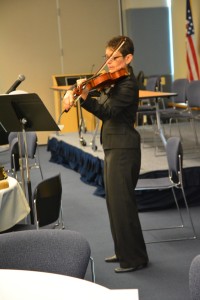
Following a practice established at previous workshops, a special program was scheduled during lunch. This time, we were uniquely privileged to be able to present music educator and performer Tamara Freeman, who demonstrated how music could be used in the classroom to teach about the difficult subject of the Holocaust. Her presentation was exceptional, not least because of the moving nature of the pieces that she played and the fact that they were performed on a viola that itself was a survivor of the Holocaust. Tamara Freeman, who recently retired from the Ridgewood School System, in 2007 was awarded a Ph.D. from Rutgers University’s arts conservatory, the Mason Gross School of the Arts, for her dissertation, “Using Holocaust Music to Encourage Racial Respect: An Interdisciplinary Curriculum for Grades K-12.”
Insofar as it is at all possible, another practice adopted by our workshops is to present the experiences of genocide survivors in their own voices. This time, we had planned to have two individuals who experienced Kristallnacht as children and later escaped to France, Mr. Charles Roman (formerly of Vienna, now of Teaneck) and Mr. Eric Mayer (formerly of Worms, now of Wayne). Unfortunately, Mr. Roman and his wife, Inge, were detained at the funeral of a dear friend and only arrived as the workshop was ending. From him, workshop participants would have heard an incredible story of flight that first took Mr. Roman and his mother to France and, then, across the Alps to Italy, where they had to elude capture by the Germans, who occupied the country after the fall of Mussolini.
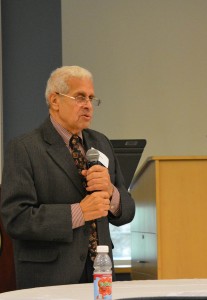 As itwas, attendees of the workshop heard the no-less remarkable story of Eric Mayer, who as a young adolescent in the aftermath of Kristallnacht was sent by his parents to live with relatives across the border in Alsace, which he and his brother with the help of the English girlfriend of a cousin were forced to flee once the Germans invaded France. Like Mr. Roman, they ended up in the non-occupied zone of the country, more commonly known as Vichy France, where again the order of the day became eluding capture and deportation by both the French and German authorities. For a while, Mr. Meyer found refuge as an apprentice in a textile factory. Eventually, however, as was the case with Charles Roman, the German occupation intensified and Mr. Mayer and his brother joined a local resistance group in southern France that on June 9, 1944, by holding a a key bridge, slowed the advance of a crack German armored unit (Das Reich) heading north to counter the Allied landing in Normandy. In recounting his ordeal, Mr. Mayer made the point that he and his brother would not have survived had it not been for the courageous help and support they received from non-Jews.
As itwas, attendees of the workshop heard the no-less remarkable story of Eric Mayer, who as a young adolescent in the aftermath of Kristallnacht was sent by his parents to live with relatives across the border in Alsace, which he and his brother with the help of the English girlfriend of a cousin were forced to flee once the Germans invaded France. Like Mr. Roman, they ended up in the non-occupied zone of the country, more commonly known as Vichy France, where again the order of the day became eluding capture and deportation by both the French and German authorities. For a while, Mr. Meyer found refuge as an apprentice in a textile factory. Eventually, however, as was the case with Charles Roman, the German occupation intensified and Mr. Mayer and his brother joined a local resistance group in southern France that on June 9, 1944, by holding a a key bridge, slowed the advance of a crack German armored unit (Das Reich) heading north to counter the Allied landing in Normandy. In recounting his ordeal, Mr. Mayer made the point that he and his brother would not have survived had it not been for the courageous help and support they received from non-Jews.
As has been the case before, in their evaluations, participants expressed their thanks for a workshop that was helpful, inspiring and informative.
E-News Archives
| 2023 | 2022 | 2021 | 2019 | 2018 | 2017 | 2016 | 2015 | 2014 | 2013 | 2012 | 2011 | 2010 | 2009 | 2008 | 2007 |Copyright ©2024 Ramapo College Of New Jersey. Statements And Policies. Contact Webmaster.

Follow Us!